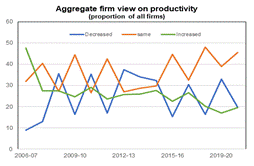
Economic update April 2024: productivity in Australian business
Key points
- There has been a decline in the proportion of businesses reporting productivity improvements over the last decade.
- This trend occurred across most industries and business sizes.
- Productivity improvements are more likely to occur in large businesses.
- Productivity outcomes differ across sectors.
Catch up: What is productivity growth?
In economics, productivity growth refers to improvements or increase in the efficiency of work or production, without a change in resources or output.
Productivity growth can result in better profit margins for business, and it can also help stimulate the jobs market. This means higher incomes and a better standard of living for people.
Recent updates
In September 2023, I released a report on productivity growth in Australia. This first report argued that the sharp drop in productivity growth over recent years was largely due to short-term issues associated with the pandemic.
In March this year, I released a second update, looking at the trending reduction in productivity growth, and how historically, productivity growth moves in ‘waves’ according to changes in technological progress.
Australia’s current view of productivity
Much of the debate surrounding productivity in Australia tends to focus on what changes the government can make to tax, their spending decisions, or regulations. Obviously, having the right fiscal and regulatory settings matter. But the actual productivity improvements come from decisions made by businesses (and governments, in their role of providing services such as education and health).
The ABS conducts an annual survey asking businesses a range of questions, including whether productivity has increased, decreased or stayed the same. The answers provide colour behind productivity trends, but can be misleading on growth rates. Productivity growth could slow even if a higher proportion of companies indicate increased productivity, as the increase could be lower than previous years.
With that as a caveat, around a quarter of businesses typically experience rising productivity, a quarter decreasing and about a third report unchanged productivity (the remaining firms report ‘don’t know,’ which is a bit of a worry). Throughout the 2010s, less businesses reported increased productivity, and there was a corresponding rise in the number reporting no changes. This outcome is consistent with ABS data that suggests productivity growth slowed over the course of that decade. This trending productivity decline was experienced across all business sizes, although it was a little later in the decade for larger firms.
The survey suggests that historically a higher proportion of large businesses experience productivity increases than small firms. This makes sense as larger businesses are more likely to have stronger cash flows, which would not only increase their chances of survival, but provide them with greater capacity to invest.
Larger businesses are also more likely to have the skilled staff necessary to find productivity improvements, as well as understand which investments are likely to provide the highest returns. They’re also more likely to have developed benchmarks to measure productivity changes.

Productivity growth declined over the preceding decade.

Over the last decade, less businesses have reported an increase in productivity.
Productivity across Australian industries and sectors
The industry with the lowest proportion of businesses experiencing productivity rises has typically been in logistics, with the highest proportion in utilities and manufacturing (manufacturing also typically has the highest proportion of businesses with declining productivity).
The differences between sectors as to the proportion of businesses experiencing increasing productivity is mostly modest. Health is where the largest proportion of firms typically experience unchanged productivity (it also has the smallest number of businesses experiencing productivity declines).
There have also been productivity cycles unique to some sectors. For example, there was a notable rise in the proportion of miners experiencing declining productivity during the investment phase of the mining boom. But there was not the same rise in the proportion of businesses experiencing increasing productivity once the investment had finished. There was also a notable rise in the proportion of retailers that experienced declining productivity last decade, a reflection of the weak consumer spending that characterised the 2010s.
What does this mean for Australia’s productivity growth?
Australian firms’ view of a decline in productivity growth over the past decade is consistent with the macro data. Secondly, larger businesses are more likely to experience productivity growth than their smaller- and medium-sized counterparts.
While governments and industry associations do have programs to help smaller firms improve productivity, further help may be required. Finally, productivity outcomes differ by industry. Some of that difference likely reflects sectors facing different cyclical challenges (such as mining and retail in the previous decade). In other sectors the challenges might be more structural.
We really do live in interesting times.


